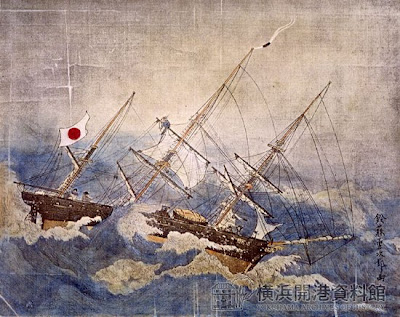
One of my favorite past times is to glean history from old newspapers and periodicals. The Hawaii State Library next to Iolani Palace and near Honolulu’s main business district features a collection of such historical periodicals on microfiche. These newspapers include such titles familiar to us here as The Friend, The Polynesian, the Pacific Commercial Advertiser, and so on. They are located in the basement level of the library where quiet thankfully reigns supreme and one can become easily absorbed by news from long ago.
In early January I was reading the early 1860 editions looking for American news, for we are approaching the sesquicentennial of the Civil War. But something quite unexpected caught my eye in more ways than one.
The January 21, 1860 edition of The Polynesian featured news of the destruction of the American Surveying Schooner Fennimore Cooper in Yeddo Bay, Japan (known to us now as Tokyo Bay). The ship was severely damaged in a typhoon some time around October 1, 1859. By some miracle no lives were lost. Captain Brooke managed to retrieve all of his instruments and surveys.
“The Japanese Government showed great kindness to the shipwrecked crew, sending men to save everything possible, and the officers say that not a single dollar’s worth was stolen. They were provided with good quarters, and furnished with provisions, servants and money. Most of the crew were afterwards taken on board the Powhatan, after her arrival from China. The officers and the balance of the crew would leave for the United States on the above vessel on 22d February next.”
What followed this report riveted me. The news reached the citizens of the Hawaiian Kingdom for the first time that the Tokugawa Shogunate was sending a first-ever official ambassadorial delegation to the United States of America in early 1860. But that was not all. The Japanese ambassadors and their entourage would be stopping in “the Sandwich Islands” as the Hawaiian Islands were often referred to.
To quote the January 21 story:
The following communication was received from the Hon. T. Harris, Minister at Yeddo, in reply to a note addressed to him by Smith & Co., as to the route which the Embassy would probably take to reach Washington, and requesting him to use his influence to have it touch at San Francisco, en route:
U.S. LEGATION, YEDDO, October 31, 1859
Dear Sir: -Your letter of yesterday was received by me this morning. In answer, I have to state that the Japanese Embassy will embark for the United States on the 22d of next February. It will consist of two Chief Ambassadors, eighteen officials of various ranks, and fifty attendants and servants-in all seventy persons.
The Embassy will proceed to Panama via the Sandwich Islands. What ports, if any, that it may touch at between the Islands and Panama will depend entirely on flag-officer Tatnall. The Embassy will cross the Isthmus by a special train, and at Aspinwall will be received by a steam frigate and be conveyed direct to Washington, without touching at any Atlantic port in the United States.
From the foregoing, you will perceive that I have no control whatsoever over the route to be taken by the Ambassadors.
I am, sir, your obedient servant,
TOWNSEND HARRIS
In a week I was due to begin teaching a personal and public speaking course at Hawaii Tokai International College in Honolulu. One of the assignments my students would be tasked with submitting was a newscast using the podcast or vodcast format. An opportunity presented itself. If any of you remember growing up watching the American TV show ‘You Are There’ I think you can guess what I had in mind. On the first day of class my American and Japanese students were genuinely surprised and excited. And so was I.
I called around and spoke to representatives of various Japanese and local Hawaii history organizations to find out if any observances of the 150th anniversary of the arrival of the first Japanese ambassadorial delegation were planned. Much to my sincere surprise none were. So, my students were tasked with developing a vodcast on this historical event, as well as calling this sesquicentennial to the attention of our public officials.
The anniversary has since passed. We were successful securing an official proclamation and signing ceremony from Honolulu Mayor Mufi Hannemann and a Joint Declaratory Certificate from the Hawaii State Legislature through Senate President Colleen Hanabusa’s office. Our repeated calls and contacts to Governor Linda Lingle’s office were never answered, much to our disappointment. The Proclamation and the Joint Declaratory Certificate were presented by my students and I to Chancellor Naoto Yoshikawa of Hawaii Tokai International College.
The Japanese Embassy of 1860 would enjoy almost two weeks time visiting Honolulu before departing for San Francisco, a trip across Panama to the Atlantic coast and a voyage that would take them to Washington, D.C., Philadelphia and New York City. Their visit caused quite a sensation for many Americans who turned out by the thousands to warmly welcome the Japanese. In 2010 celebrations commemorating their arrival in America were held everywhere –except Hawaii.
This historical and educational blog is dedicated to publicizing the 1860 visit by the Japanese ambassadors. I am an historian though not a Japanese history scholar. Nevertheless, I have decided that a book about this milestone in Japanese, Hawaiian and American history must be written and published and I would be the one to do it. This will be both exciting and challenging –which makes it all the more fun!









